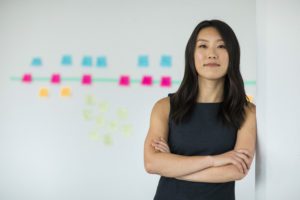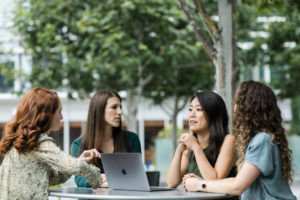For as long as she can remember, Nancy Yu has been entranced by the intersection of science and technology. In fact, as she describes it, she imagines a world in which no barriers exist between these two elements. A world in which science and technology can come together and be leveraged for the betterment of society. After learning how the various elements within the science and healthcare fields fit together, the concept of AllStripes was born.
Co-founded with Onno Faber, who has a rare disease, neurofibromatosis type 2 (NF2), AllStripes was created from Nancy and Onno’s vision. Through AllStripes, patients and family members have the opportunity to join in various medical studies from the comfort of their own homes. This offers the rare disease community the power to advance treatment and awareness. After all, patients are the experts in their conditions.
Recently, Patient Worthy sat down with Nancy to discuss AllStripes, rare disease research, and the push towards easier and more targeted drug development.

Photo by Alison Yin/Alison Yin Photography
Nancy’s Background
Initially, Nancy grew up in the Bay Area, an area ripe and concentrated with workers in the technology industry. Through her upbringing, she developed a keen interest in science and laboratory research. She explains:
I was at an intersection between doing science and research in the lab and trying to figure out how to get that technology into the real world. While there was a lot of lab research, biotechnology, and neuroscience, it wasn’t really the place I was looking for. I wanted to figure out how to approach and change the broader system rather than just one corner of the world.
Eventually, Nancy moved away from the West Coast to pursue further studies in Finance, Economics, and Molecular Biology at the University of Pennsylvania. Following her educational experience, she later transitioned into Wall Street to become a biotech investor. She describes her time on Wall Street as fast-paced:
I was working with a lot of different science and biopharma companies who were developing treatments, and learned how to tell these stories to investors to raise more capital. It definitely gave me deeper insight into the different aspects that it takes to just connect the puzzle pieces that make science.
As she gained this deeper insight, and even started investing, something began to change. Although she appreciated the opportunity to wear these different hats, Nancy was missing something: the actual, hands-on science. Ultimately, her desire to have a more scientific-focused role brought her to join 23andMe as the Head of Corporate Development. 23andMe utilizes DNA kits to not only inform people about their health and genetics through easily-digestible results but to enhance and fuel scientific research by answering various questions.
Her job gave her the opportunity to see how combining life science, medical science, and lived experience could benefit the medical field as a whole. She began taking the lead on trying to set up the drug discovery side of the business and transform knowledge into actual treatments. Nancy says:
It was very cool to see the power of this consumer platform and drive a new model in drug discovery. How can we improve this very long process of drug development? How could we bring patients into the process earlier and develop treatments that actually matter?
Rare Disease Drug Development
Although Nancy does not personally have a rare disease, many people in her life do. So, as she delved deeper into the drug development process, Nancy noticed an unmet need: effective drug development for people within the rare disease community.
Then, in 2016, she met Onno Faber, an entrepreneur, public speaker, and rare disease patient advocate. Onno has NF2, a rare genetic disorder which causes benign tumors to grow on healthy nerve tissue. After a tumor developed in Onno’s left ear, and one on his liver, in his 30s, he was puzzled; these seemingly came out of nowhere. Nancy explains:
But when he went to the doctor, the doctor just told him to Google it. I started talking to a lot of families with different conditions and heard the same frustrations from them: a lack of information and medical professionals lacking sufficient knowledge.
Nancy began thinking back on her time in life sciences. She realized that for researchers or those looking to set up trials, there was a lack of tools and language to find and engage patients. There were also few existing good databases to source data from. So she pondered: what could she do to help? How could she move research forward?
Soon, Nancy and Onno joined forces to change patients from bystanders to active participants in the drug development and medical research process. And just like that, AllStripes was born.
AllStripes
Altogether, there are over 7,000 rare diseases in the world; 1 in 10 people are affected by a rare disease. Yet due to a lack of awareness and data, as Nancy explains, these people are still largely underrepresented in clinical trials and medical research. AllStripes was created with one powerful and impactful goal in mind:
To unlock more treatment options for people with rare diseases.
Since its initial founding, AllStripes has garnered a team of over 100 passionate, mission-driven team members across research, data, and life sciences. AllStripes offers an in-depth research platform that is dedicated to rare diseases. Nancy shares:
For each condition on the platform, patients give us permission to gather all of their medical records from all of their professionals and consolidate it. Parents can sign up on behalf of their children to give us that permission. What we’re really looking for is patient engagement and any data about the disease itself, from natural history and burden of illness to anything that they feel will help move their drug program forward.
This process of collection is free for all users, thanks to funding from investors and researchers. Additionally, all data collected is available to users, who can use it for ongoing care. For example, they can see all of their hearing tests or radiology treatments in one place. The data is also safe, as Nancy explains:
Patients own their own data and can decide to leave the platform whenever they want. They also consent to having that data used to benefit multiple different research projects. What we do on the back end is de-identifying data for research purposes. We look at all of the different symptoms or lab results and can plot that in ways for researchers to best access it.
Through this, AllStripes meaningfully supports research programs with companies such as Novartis and Taysha Gene Therapies. The company also provides program updates and community insights along the way.

Photo by Alison Yin/Alison Yin Photography
(Provided to PW by AllStripes)
Of course, not every condition listed on AllStripes has active research programs. So AllStripes has an internal research team that helps spur research and data collection. Nancy says:
Rare disease research is like the chicken-or-egg problem. If you know more about any given condition, more researchers are willing to work on it. But it’s difficult to set up a research program for something lesser known. Our internal research team creates a map of the disease so that it instigates interest from other researchers. They’ll look at demographics and high level information, or may take on specific studies like those on sibling pairs, and make it available to others.
It can take anywhere from a day to over a month to source patient records. But Nancy and her team will pursue knowledge as far as possible. This motivation and drive to improve research and drug development show in AllStripes’ growth over the years. In fact, says Nancy:
We started with a couple of patient communities and have grown to 50 communities. Better yet, we plan to double that in the next year.
Stay tuned for Part 2 of our interview, where we go more in-depth into the different patient communities on AllStripes, the roadblocks, and accomplishments of building this new platform, and where Nancy plans to take AllStripes in the future.






